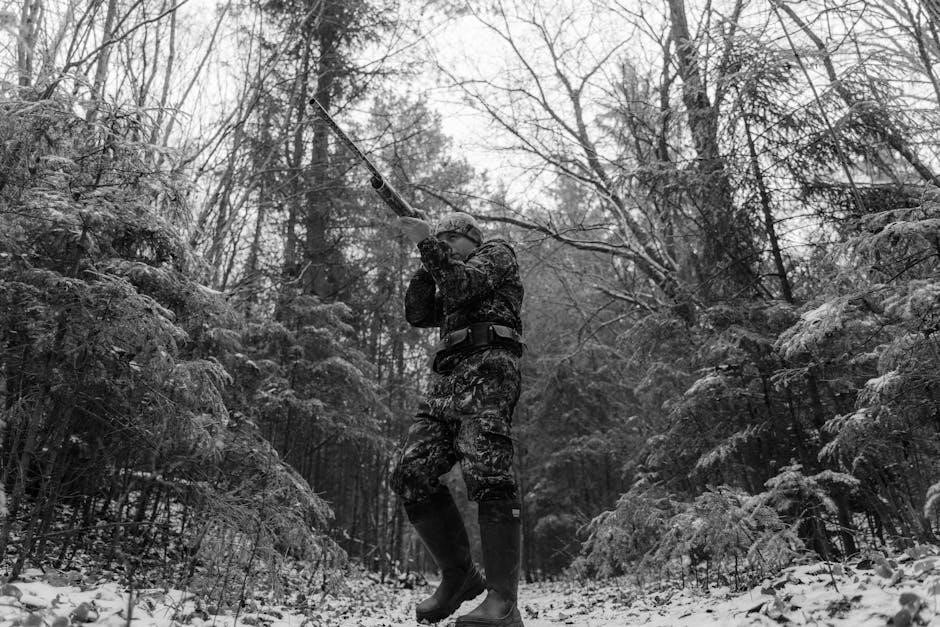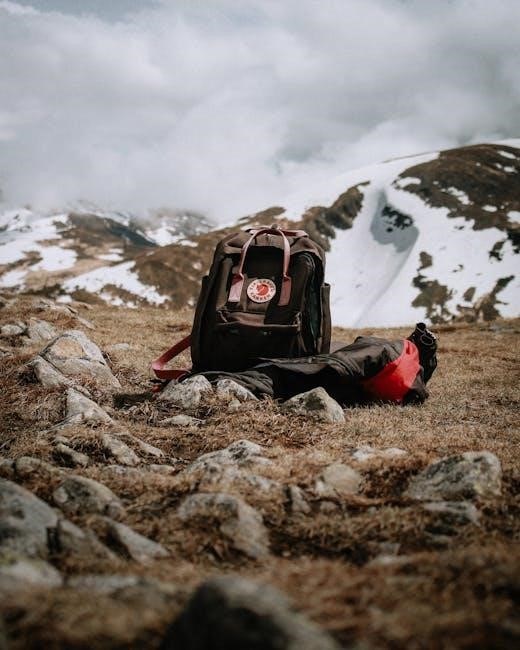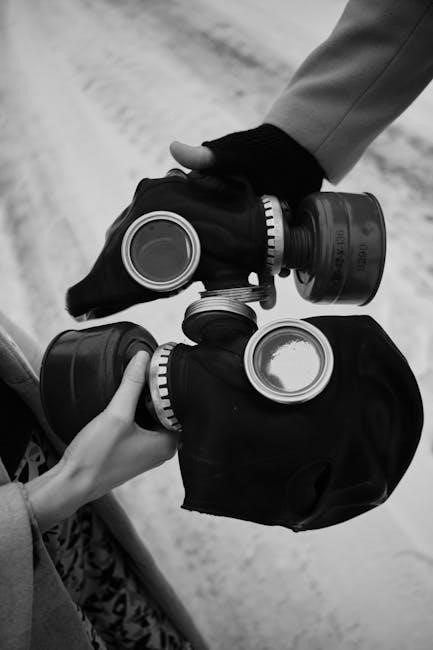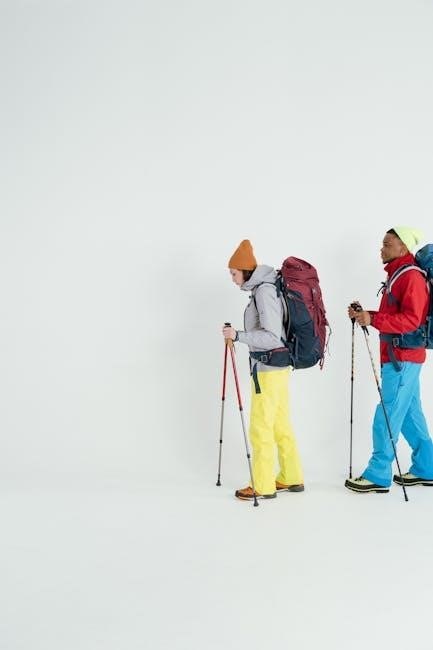A winter preparedness checklist is a vital tool for ensuring safety and readiness during cold weather․ It covers key areas such as home insulation, emergency supplies, and vehicle safety to help you stay proactive and prepared for potential challenges․
Why Winter Preparedness is Essential
Winter preparedness is crucial to safeguarding lives and property during extreme weather conditions․ Freezing temperatures, heavy snowfall, and power outages can disrupt daily life and create emergencies․ Without proper planning, risks like hypothermia, home damage, and food shortages escalate․ A well-structured checklist ensures readiness, helping individuals and communities navigate challenges effectively․ It minimizes risks, reduces financial losses, and provides peace of mind․ Preparedness also supports vulnerable populations, such as seniors and pets, who face heightened risks during cold months․ By addressing essential needs like emergency supplies, heating, and communication, winter preparedness fosters resilience and ensures safety during unpredictable weather events․
Key Components of a Winter Preparedness Checklist
A comprehensive winter preparedness checklist includes essential elements to ensure safety and readiness․ It begins with emergency supplies like flashlights, batteries, first aid kits, and non-perishable food․ Home preparation involves insulating pipes, servicing heating systems, and sealing drafts․ Vehicle readiness is another critical component, requiring winter tires, snow shovels, and emergency kits․ Communication devices, such as charged phones and two-way radios, are vital for staying informed and connected․ Additionally, planning for alternative heat sources and understanding cold-weather safety measures, like preventing hypothermia and frostbite, are key․ Regularly reviewing and updating the checklist ensures all aspects are addressed, providing a structured approach to manage winter challenges effectively and efficiently․

Home Winter Preparedness
Ensure your home is ready for cold weather by insulating pipes, servicing heating systems, and stocking emergency supplies․ Prepare for potential power outages and freezing temperatures․
Insulating Your Home for Cold Weather
Insulating your home is crucial for maintaining warmth and reducing energy costs during winter․ Start by checking attic, wall, and floor insulation levels․ Use foam pipe covers to protect exposed pipes in unheated areas like the garage or basement․ Seal drafts around windows and doors with weatherstripping or caulk․ Consider installing storm windows or thermal curtains for added insulation․ Insulate your water heater and ensure proper ventilation in insulated spaces to prevent moisture buildup․ Additionally, insulate any outdoor faucets and hoses to prevent freezing․ By taking these steps, you can keep your home warm, reduce heat loss, and protect your plumbing system from freezing temperatures․
Preparing Your Plumbing for Freezing Temperatures
Protecting your plumbing from freezing temperatures is essential to prevent costly damage and ensure continuous water supply․ Insulate exposed pipes in unheated areas like the garage, basement, or crawlspace using foam pipe insulation․ Disconnect and drain outdoor hoses to avoid freezing․ Seal any gaps or cracks near pipes to prevent cold air infiltration․ Let cold water drip from faucets served by exposed pipes during extreme cold snaps․ Consider installing freeze-proof faucets or frost-proof spigots for outdoor use․ If pipes freeze, turn off the main water valve and contact a professional․ Regularly inspect pipes for signs of freezing, such as reduced water flow․ Taking these steps can help safeguard your plumbing system during harsh winter conditions․
Heating System Maintenance Tips
Regular heating system maintenance is crucial to ensure efficiency, safety, and reliability during winter․ Start by scheduling a professional inspection to check for worn or damaged components․ Replace air filters monthly to improve airflow and reduce energy costs․ Clear debris from vents and ensure they are unblocked for proper circulation․ Bleed radiators to remove airlocks and enhance heat distribution․ Inspect and clean the chimney to prevent carbon monoxide buildup․ Test the thermostat to ensure it accurately regulates temperature․ Consider upgrading to a programmable thermostat for better control․ Check for any leaks in the ductwork and seal them to prevent heat loss․ Finally, stock up on fuel or ensure gas lines are functioning properly․ These steps will help maintain your heating system’s performance throughout the winter season․
Creating a Home Emergency Kit
A home emergency kit is essential for winter preparedness, ensuring you can sustain yourself and your family during power outages or extreme cold․ Start by stockpiling non-perishable food and at least three gallons of water per person․ Include a first aid kit, flashlights, and extra batteries․ Add a battery-powered radio and a whistle to signal for help if needed․ Warm blankets, extra clothing, and layered winter gear are crucial․ Don’t forget essential medications and personal hygiene items․ Incorporate a portable charger for devices and cash in small bills․ Check expiration dates and update supplies annually․ Store the kit in an easily accessible location, ensuring all household members know where it is․ This kit will provide peace of mind and practical support during unexpected winter emergencies․

Vehicle Winter Preparedness
Ensure your car is winter-ready with a maintenance checklist, emergency kit, and safe driving practices to handle cold weather and potential breakdowns effectively․
Winter Car Maintenance Checklist
A winter car maintenance checklist ensures your vehicle is ready for cold weather․ Check the battery health, antifreeze levels, and tire pressure․ Replace worn-out wiper blades and ensure proper windshield washer fluid․ Inspect tires for tread depth and consider snow tires․ Top up fluids, including oil, transmission, and brake fluids․ Check the heating system and defroster functionality․ Ensure the exhaust system is clear of blockages․ Test lights, signals, and brakes․ Carry a winter emergency kit with items like a flashlight, first aid kit, jumper cables, ice scraper, and sand․ Keep the gas tank at least half full to prevent fuel line freezing․ Regularly service the vehicle before winter․ These steps ensure reliability and safety during harsh winter conditions․ Stay prepared to handle unexpected situations on the road․
Building a Winter Emergency Kit for Your Car
A winter emergency kit for your car is essential to stay safe during cold weather․ Include a flashlight, extra batteries, a first aid kit, jumper cables, and an ice scraper․ Add sand or cat litter for traction, warm blankets, and a small shovel․ Pack water, non-perishable snacks, and a portable phone charger․ Ensure all items are easily accessible and check expiration dates․ Regularly inspect the kit to replace expired or damaged goods․ This preparation helps you handle unexpected situations like breakdowns or being stranded․ Customize the kit based on your location and the number of passengers․ Stay prepared to keep yourself and others safe during winter driving conditions․
Winter Driving Safety Tips
To ensure safe winter driving, always slow down and increase your following distance․ Use low beam headlights in snowy or icy conditions to improve visibility․ Avoid sudden movements, such as abrupt braking or sharp turns, as these can lead to skidding․ Keep your windshield and windows clean to maintain clear vision․ If you encounter black ice, steer gently in the direction you want the car to go and avoid slamming on the brakes․ Stay at least 200 feet behind snowplows to avoid being hit by debris․ Keep your gas tank at least half full to prevent fuel lines from freezing․ Carry a fully charged phone and know alternative routes in case of road closures․ Winter driving requires patience and caution to stay safe on the roads․
Preparing for Snow Removal Equipment
Ensuring your snow removal equipment is ready for winter is crucial for maintaining safety and accessibility․ Start by servicing your snow blower or plow, checking for worn-out parts, and ensuring all components are in good working condition․ Store shovels, ice scrapers, and sand buckets in easily accessible locations․ Check the fuel levels of powered equipment and top them off to prevent condensation․ Lubricate moving parts to protect against rust and freezing․ Inspect tires and blades for damage and replace them if necessary․ Keep backup equipment, such as an extra shovel or ice melt, on hand in case your primary tools are unavailable․ Properly preparing your snow removal gear ensures you’re ready to tackle winter weather effectively and safely․
Emergency Supplies for Winter
Stock a 3-day supply of water, non-perishable food, flashlights, batteries, and first aid kits․ Include warm blankets, chargers, and essential medications in your emergency kit․
Stockpiling Food and Water for Emergencies
Stockpiling food and water is crucial for winter emergencies; Aim for at least a 3-day supply of water (1 gallon per person per day) and non-perishable food․ Include high-energy snacks, ready-to-eat meals, and manual can openers․ Store food in airtight containers to maintain freshness․ Don’t forget a multi-tool knife and flashlights with extra batteries․ Rotate supplies every 6 months to ensure they remain usable․ Consider dietary restrictions and pet needs when assembling your stockpile․ A well-prepared pantry ensures you can sustain yourself and your family during prolonged power outages or snowstorms․ Always check expiration dates and replace items as needed to keep your emergency stash reliable and safe․ This step is essential for staying self-sufficient during winter crises․
Lighting and Power Solutions for Blackouts
During winter blackouts, reliable lighting and power solutions are essential․ Stock flashlights, extra batteries, and rechargeable lanterns to ensure visibility․ Consider solar-powered lights or battery-operated candles for safer alternatives to open flames․ A portable power bank or generator can charge critical devices like phones and medical equipment․ Install a UPS for computers and sensitive electronics to prevent data loss․ Test all equipment before winter to ensure functionality․ Store backup power sources in an accessible, dry location․ Regularly check battery expiration dates and replace them as needed․ A well-prepared lighting and power system helps maintain safety and comfort during extended outages․ Always follow safety guidelines when using generators to avoid risks like carbon monoxide poisoning․
Battery and Charger Essentials
Stockpile essential batteries for flashlights, radios, and medical devices․ Include a variety of sizes, such as AA, AAA, and D batteries, and consider rechargeable options․ Invest in a portable power bank to charge smartphones and small devices during outages․ Keep a car charger for vehicles to ensure connectivity on the go․ Store extra chargers for critical appliances and test them regularly․ Organize cables and adapters in a designated container for easy access․ Replace expired or corroded batteries to maintain reliability․ Consider a UPS for backup power to protect electronics․ Regularly check battery expiration dates and rotate stock to ensure freshness․ A well-stocked collection of batteries and chargers is vital for staying connected and operational during winter emergencies․ Always store them in a dry, accessible location to prevent damage and ensure readiness;
First Aid Kit for Winter Injuries
A well-stocked first aid kit is crucial for addressing winter-related injuries, such as cuts, frostbite, and hypothermia․ Include bandages, antiseptic wipes, and pain relievers․ Add cold and flu medication, as respiratory issues rise in winter․ A thermometer is essential for monitoring body temperature․ Pack gloves and a warm blanket to prevent hypothermia․ Include supplies for treating frostbite, such as warm compresses and sterile dressings․ Don’t forget tweezers for removing splinters and scissors for cutting bandages․ A first aid manual is vital for guidance․ Store all items in a waterproof container and ensure family members know its location․ Regularly check expiration dates and restock as needed to maintain readiness for emergencies․
Communication Devices for Emergencies
Communication devices are critical during winter emergencies to stay connected and receive updates․ Include a cell phone with a charger, backup power sources like batteries or a portable generator, and a two-way radio for when networks fail․ A whistle can signal for help if trapped, and a NOAA Weather Radio ensures access to emergency alerts․ Consider registering for emergency notifications from local authorities․ Store these devices in an easily accessible location and ensure all household members know how to use them․ Regularly test batteries and charge devices before storms to maintain reliability․ Proper communication tools can be a lifeline during power outages or severe weather events, helping you stay informed and connected until help arrives․
Health and Safety During Winter
Winter preparedness includes prioritizing health and safety to prevent hypothermia, frostbite, and injuries․ Ensure access to warm clothing, medications, and emergency supplies like blankets and first aid kits․
Preventing Hypothermia and Frostbite
Preventing hypothermia and frostbite is crucial for winter safety․ Hypothermia occurs when body temperature drops too low, while frostbite affects skin exposed to extreme cold․ Stay dry, as moisture accelerates heat loss․ Wear layered, breathable clothing, including a hat and gloves, to retain warmth․Protect extremities like hands, feet, and ears, as they are most vulnerable․ Avoid prolonged exposure to cold winds and icy conditions․ Monitor vulnerable individuals, such as seniors and children, who are at higher risk․ Recognize symptoms like shivering, confusion, or numbness and seek medical help immediately if they arise․ Ensure access to warm shelter and emergency supplies to address these conditions promptly․

Winter Safety Tips for Seniors
Seniors are particularly vulnerable during winter due to health conditions and mobility challenges․ Ensure their home is warm, with temperatures above 65°F to prevent hypothermia; Check for proper insulation and working heating systems․ Remove tripping hazards like icy walkways and loose rugs to prevent falls; Encourage wearing layered, warm clothing indoors and outdoors․ Provide non-slip shoes and canes for stability․ Stock an emergency kit with essentials like medications, blankets, and a flashlight․ Arrange for a supportive network to check in regularly, especially during severe weather․ Educate them on recognizing hypothermia and frostbite symptoms․ Ensure access to grab bars and non-slip mats in bathrooms for added safety․ These steps can significantly enhance their winter safety and well-being․
Mental Health During Winter Months
Winter’s shorter days and colder weather can impact mental health, leading to issues like Seasonal Affective Disorder (SAD)․ Staying socially connected and engaged in activities helps combat isolation․ Ensure access to natural light or use light therapy lamps to improve mood․ Regular physical activity, even indoors, boosts endorphins and reduces stress․ Mindfulness practices, such as meditation or journaling, can enhance emotional well-being․ Maintain a consistent routine, including healthy eating and sleep schedules, to stabilize mood; Stock a mental health kit with calming tools like books or puzzles․ Encourage open conversations about feelings and seek professional help if symptoms persist․ Preparation for mental health challenges is as crucial as physical preparedness during winter․
Physical Safety Tips for Ice and Snow
Physical safety during icy and snowy conditions requires careful preparation and awareness․ Wear insulated, waterproof boots with good traction to prevent slips․ Use handrails when walking on icy stairs or steps․ Avoid overexertion while shoveling snow, as it can lead to strain or heart issues․ Sprinkle salt or sand on walkways to improve traction․ Keep your phone nearby in case of emergencies․ Dress in layers to maintain body heat, and avoid distractions like texting while walking on icy surfaces․ Carry a small bag of kitty litter or sand in your car for emergency traction․ Stay visible by wearing bright or reflective clothing․ Always clear snow from your vehicle completely before driving․ Properly prepare your home and vehicles to ensure safety and confidence during winter conditions․

Community and Pet Preparedness
Build a supportive neighborhood network and ensure pets have essential supplies like food, water, and warm shelter․ Check on vulnerable neighbors and keep pets safe indoors during extreme cold․
Building a Supportive Neighborhood Network
A strong neighborhood network is crucial for winter preparedness․ Organize community meetings to discuss emergency plans and share resources․ Encourage neighbors to check on vulnerable individuals, such as seniors or those living alone․ Create a group chat or mailing list for quick communication during storms․ Share contact information for local emergency services and snow removal providers․ Collaborate on supplies like sand, salt, and shovels to ensure everyone is equipped for icy conditions․ Offer to help neighbors with tasks like clearing driveways or running errands during severe weather․ Building this support system fosters resilience and ensures no one faces winter challenges alone․

Preparing Your Pets for Winter
Ensuring your pets’ safety during winter is essential․ Provide a warm, draft-free shelter and thick bedding to protect them from cold floors․ Keep their fur well-groomed to prevent matting and ice accumulation․ Limit exposure to harsh weather, especially for short-haired breeds․ Stock up on pet food, water, and medications in case of supply shortages․ Avoid leaving pets in vehicles, as cold temperatures can be deadly․ Ensure their ID tags are secure in case they escape during a storm․ Provide mental stimulation through indoor activities to combat cabin fever․ Consult your veterinarian for advice on winter care tailored to your pet’s needs․ Keep toxic substances like antifreeze out of reach and monitor their health for signs of distress․ Stay vigilant to ensure your pets remain safe and comfortable throughout the winter season․ Always prioritize their well-being during extreme weather conditions․
Winter Safety for Outdoor Animals
Protecting outdoor animals during winter requires careful preparation․ Ensure they have access to a warm, dry shelter with adequate bedding like straw․ Provide fresh water daily, using heated bowls to prevent freezing․ Increase food portions to help them cope with cold temperatures․ Regularly inspect their living areas for hazards like sharp edges or slippery surfaces․ Avoid leaving them exposed to harsh winds or heavy snowfall; Keep antifreeze and other toxic substances out of reach․ Check their health daily for signs of distress, such as shivering or lethargy․ Create windbreaks using tarps or snow fencing to shield them from harsh weather․ Ensure their enclosures are well-ventilated to prevent ammonia buildup from urine․ Stay attentive to their needs to keep them safe and healthy throughout the winter season․

Additional Winter Preparedness Tips
Stay informed about weather forecasts, budget for emergencies, and review your preparedness plan regularly․ Ensure backup heating sources are safe and functional, and check insurance coverage for winter-related damages․
Staying Informed About Weather Conditions
Staying informed about weather conditions is crucial for effective winter preparedness․ Sign up for emergency alerts from reliable sources like www․vaemergency․gov to receive real-time updates․ Monitor local weather forecasts regularly, especially during periods of extreme cold or potential storms․ Understanding the differences between weather watches, warnings, and advisories can help you respond appropriately․ For instance, a winter storm warning indicates imminent severe weather, while a winter weather advisory suggests less severe but still hazardous conditions․ Keep a battery-powered radio on hand in case of power outages to stay updated․ Additionally, ensure your smartphone is registered for emergency notifications to receive critical information when you’re on the go․ By staying informed, you can make timely decisions to protect yourself, your family, and your property from winter hazards․
Budgeting for Winter Emergencies
Budgeting for winter emergencies is essential to ensure financial preparedness for unexpected situations․ Allocating funds for emergency supplies, such as food, water, and medications, can prevent financial strain during crises․ Consider setting aside a portion of your budget for potential home repairs, such as insulation or plumbing fixes, which are common during cold weather․ Additionally, budget for vehicle maintenance, including snow tires or emergency kits, to avoid costly last-minute solutions․ Review your insurance policies to ensure they cover winter-related damages, and save for potential increases in heating bills․ Lastly, set aside a small emergency fund for unforeseen expenses, such as power outages or snow removal equipment․ By planning ahead, you can reduce financial stress and stay safe during winter emergencies․
Reviewing and Updating Your Preparedness Plan
Regularly reviewing and updating your winter preparedness plan is crucial to ensure it remains effective and relevant․ Start by assessing your current supplies and updating expiration dates for food, water, and medications․ Check for any changes in household needs, such as new members or pets, and adjust your plan accordingly․ Incorporate lessons learned from past winters, such as areas where your preparedness fell short; Involve all household members in the review process to ensure everyone understands their roles and responsibilities․ Update your emergency contact list and communication strategies to reflect any changes․ Finally, verify that your plan aligns with local emergency guidelines and recommendations․ By staying proactive, you can ensure your plan remains comprehensive and ready for any winter scenario․



